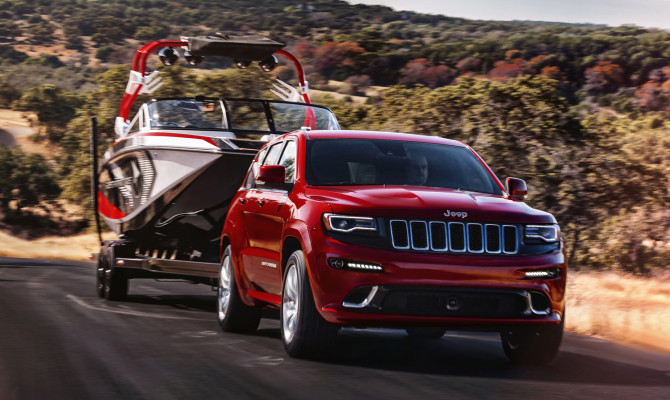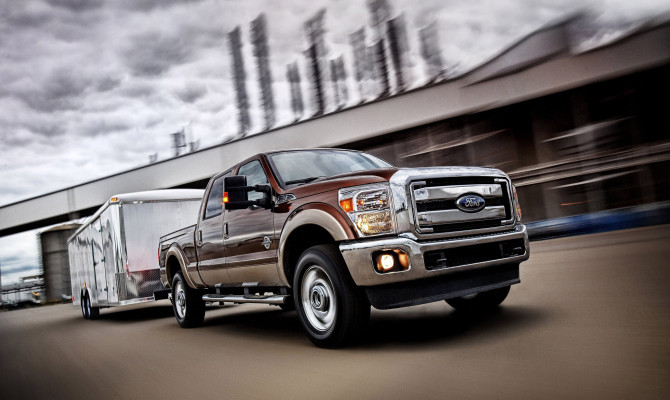“Remember, your towing capacity is equal to the capacity of the weakest link in the system.”
Towing a trailer just might be one of the most stressful driving situations for some truck owners. For one thing, it is not easy to manouevre around corners and change lanes with that extra length behind your truck. Backing up can be challenging. And towing up a steep hill can be tough on your truck. Whether you tow a boat, car, snowmobiles, or motorcycles, custom truck accessories can make towing less nerve-wracking.
Don’t Tow Too Much Weight
Pulling too much weight can be very dangerous. Check your owner’s manual to find your vehicle’s towing capacity, including the maximum gross trailer weight and tongue weight it can handle. Tongue weight is the downward force exerted on the hitch ball by the trailer coupler. In most cases, it is about 10 to 15 percent of gross trailer weight. Tongue weight of up to 300 pounds can be measured on a household scale by resting the trailer coupler on the scale and placing the scale on a box so that the coupler is at its normal towing height. The trailer must be fully loaded and level.
Use the Right Hitch and Other Equipment
Just as each vehicle has a maximum towing capacity so too does each trailer hitch, hitch ball, ball mount and safety chain. To tow safely, make sure every component you use is ready to handle the weight of your fully loaded trailer. Remember, your towing capacity is equal to the capacity of the weakest link in the system.
Choosing a Trailer Hitch
All trailer hitches feature a class rating, as well as a weight rating, so be sure the hitch can accommodate the loaded trailer. For instance, Reese Class 2 (avg $159) hitches have a maximum rated capacity of 350 pounds tongue weight and 3,500 pounds gross trailer weight. Class IV (avg $175) receiver-style hitches have a maximum capacity of 1,200 pounds tongue weight and 12,000 pounds gross trailer weight.
If you need more towing capacity than the traditional receiver-style weight distributing hitch, then you need to step up to a fifth-wheel or gooseneck hitch. Prices start at $650.
Choosing a Hitch Ball
If you have a drawbar style hitch, the hitch ball usually is built right into it. But if you have a receiver-style hitch, you’ll need to choose your own hitch ball.
Like vehicles and trailer hitches, hitch balls also are assigned a maximum tongue weight and gross trailer weight rating.
Hitch balls are made from a variety of materials, and some are available in a choice of finishes, including chrome. They cost about $12 to $14.
The hitch ball diameter must be the same diameter as the trailer coupler (1 7/8 inches, 2 inches or 2 5/16 inches).
The shank diameter of the hitch ball should be the same as the hole diameter in the ball mount.
The shank length should be long enough to allow at least two threads to be visible when the hitch ball is installed and the nut completely tightened.
Load Your Trailer Properly
Rule of thumb is roughly two-thirds (60 to 66 percent) of the gross load weight should be positioned toward the front half of the trailer. Place large or heavy objects on the trailer first. Tie these objects down securely and from several angles to ensure they do not shift. Pack remaining items in a manner that maintains balance of the trailer. Once the trailer is loaded, double-check the positioning and stability of the cargo. Better safe than sorry.
Recent Comments
- { Enjoyed your Forest of Bowland in the BMW X5M, particularly the photo of the BMW in front of the main part of Stonyhurst College where... }
- { Bantam designed the Jeep, not Willy's or Ford. The American military gave the original Bantam prototype to Willys and Ford to copy. There is plenty... }
- { All Escalades come with a 6.2-lilter V8 engine that produces 420 horsepower. A six-speed automatic is the only transmission offered and drives the rear wheels.... }
- { Alexandra is an excellent journalist. }
Popular Posts
- Journey to a ‘Sparkling’ Luxury Okanagan Resort “Four lucky readers will put a Dodge Journey’s weekend-...
- The Need For Speed: Hike Those Highway Limits More than half of those polled believe the province sho...
- Drives-U-Crazy… Erratic drivers. An early morning drive from Kelowna to Vancouver is nor...
- Readers Respond: The Pros and Cons of Increasing B.C. Speed Limits Increasing the speed limits will only increase risk to...
- Honda CR-V Review: The Compact Crossover To Get Things Done The CRV is a very stylish and aerodynamic crossover veh...








